How Effective Is PRP For Hair Loss & Hair Growth?
Hair loss is a common and distressing condition that affects approximately 50 million men and 30 million women in the US. Hair loss can result from a variety of factors, including age, stress, genetics, and an autoimmune condition. Regardless of the cause, hair loss can lead to insecurity and even depression symptoms in those that experience it. While there seem to be many hair loss treatments and supplements available on the market, it can be very hard to tell which are actually effective, and even those topical or oral medications that work well can cause undesirable side effects. For a long time, many believed that the most effective course of action was undergoing plastic surgery with a hair transplant. Luckily, board-certified, expert dermatologist Dr. Michele Green in New York City has an effective, non-surgical option that works to prevent hair loss: platelet-rich plasma injections.
Platelet-rich plasma (PRP) therapy works through the use of the patient’s blood to strengthen hair follicles and promote hair growth. PRP contains a range of growth factors and proteins that are essential for tissue regeneration, wound healing, and stem cell growth. When injected into areas of the scalp as a part of the treatment plan for hair loss, PRP therapy improves hair density and thickness, lengthens the growth phase of hair follicles, and encourages overall rejuvenation of the scalp. PRP is considered an excellent treatment option due to its effectiveness, lack of downtime required, and minimal to no side effects associated with treatment. If you are tired of experiencing hair loss and ready to thicken and regrow your hair with PRP injections, Dr. Green is here to help.
When it comes to hair loss treatment, it is best to consult an experienced, board-certified dermatologist, such as Dr. Green. Dr. Green has been effectively treating patients in her Upper East Side New York City dermatology office for more than 25 years. An expert in a wide range of medical and cosmetic procedures, Dr. Green has been praised by many patients for her proficiency in such treatments as PRP injections, Botox injections, laser therapy, microneedling, and much more. Known for her high patient satisfaction, Dr. Green has been voted one of the best healthcare providers in New York City by Castle Connolly, New York Magazine, Super Doctors, and The New York Times due to her dedication and accessibility to her patients. When you consult with Dr. Green, she will assess your hair loss and create a PRP hair restoration plan to help you look and feel like your best self again.
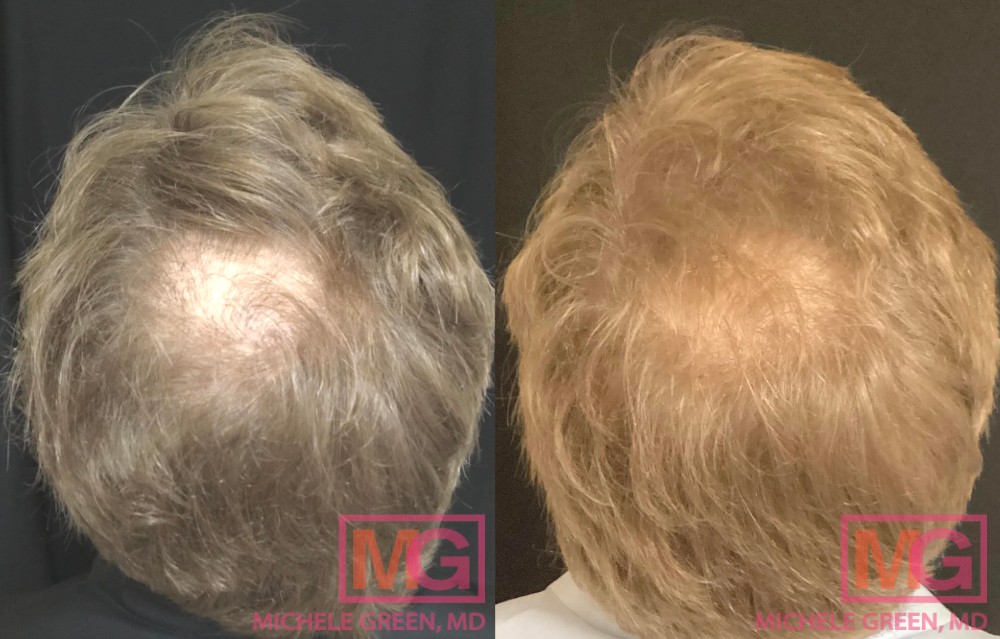
What is Platelet-Rich Plasma (PRP)?
Platelet-rich plasma (PRP) therapy is a modern treatment that uses the growth factor proteins found in the patient’s blood to promote healing, strengthen and encourage growth of new cells, and assist with blood clotting. PRP treatment is commonly used for various medical needs, specifically to heal wounds or musculoskeletal injuries, rejuvenate the skin, and prevent hair loss. Dermatologists commonly use PRP treatment to address hair loss conditions such as male pattern baldness or female pattern baldness – also known as androgenetic alopecia – and alopecia areata. While the treatment is not currently FDA approved to treat hair loss, the procedure still helps to prevent thinning hair, increase hair thickness, and promote new hair growth with long-lasting results.
How does PRP work for hair loss?
PRP for hair loss involves injecting the high platelet count plasma found in the patient’s blood into the scalp where hair loss is beginning to show. This platelet-rich plasma activates proteins in the body called “growth factors,” which serve various helpful purposes. Growth factors found in PRP include, but are not limited to:
- Epidermal Growth Factor (EGF) — stimulates growth of blood vessels, collagen and cells
- Fibroblast Growth Factor-2 (FGF-2) — increases growth of blood vessels and specialized cells
- Platelet-derived growth factor (PDGF) — aids in cell, skin, and blood vessel formation
- Insulin-Like Growth Factor-1 (IGF-1) — regulates normal physiology in almost every body cell
- Transforming Growth-Factor-Beta (TGF-b) — regulates tissue repair and cell growth
- Vascular Endothelial Growth Factor (VEGF) — stimulates the formation of new blood vessels
When it comes to prevention of hair loss, these autologous growth factors can work to improve circulation in the treatment area, which can help to thicken the hair follicle. As a result, the new hair growth at the injection site is thicker and healthier looking. Furthermore, these growth factors can help to heal and reactivate hair follicles, increasing hair count in the area. The proteins also work to stimulate the papilla cells, which help to promote new hair growth. Altogether, this means that PRP treatment works to strengthen the hair follicle for thicker hair and activate previously inactive hair follicles for new growth, which serves to counteract hair loss.
What types of hair loss can PRP treat?
Androgenic alopecia
Androgenic alopecia, often commonly referred to as male-pattern baldness or female pattern hair loss, is a common condition that can affect both men and women. Androgenic alopecia often follows a predictable receding of the hairline. For men, the loss of hair begins near the temples, forming the characteristic “M” shape of the hairline, and can also occur on the crown of the head. For women, alopecia typically begins with hair thinning on the top of the head, which contributes to a widening of the part. Androgenic alopecia is related to increased levels of androgen hormones, which can affect the hair growth cycle and the hair follicles, leading to thinning hair and general hair loss. PRP treatment is an effective way to address androgenic alopecia to counteract the negative effects of the increased hormone levels. When PRP is injected into the area of the scalp where thinning is occurring, the treatment works to strengthen the hair follicles for thicker hair regrowth.
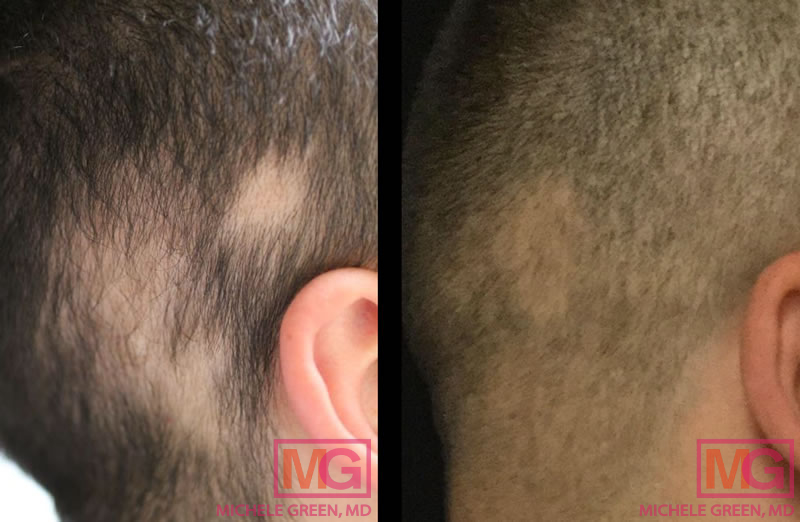
Alopecia areata
Alopecia areata is an autoimmune disorder that causes the body to damage its hair follicles, which can lead to hair loss anywhere on the body, including the scalp. As the body’s white blood cells attack the hair follicles, hair growth slows dramatically and hair falls out. Generally, alopecia areata appears as non-scarring bald patches and can develop irregularly on the scalp. Alopecia areata can be unpredictable and can happen to patients of any age or gender. It is linked to a genetic component, rather than any acute traumatic or stressful incident. For some patients, hair regrowth may occur within 12 months and then hair loss will not happen again, but it is difficult to determine the pattern. Luckily, PRP can help with the hair regrowth process by activating growth factor proteins to strengthen hair follicles and increase hair count for increased growth.
Telogen effluvium
Telogen effluvium is a type of hair loss that occurs as a result of a major stressor or traumatic event. Patients with telogen effluvium will experience a rapid, diffuse shedding or thinning of hair on the scalp two or three months after the initial stressor. Common stressors include a death in the family, divorce, surgery, extreme illness, childbirth, anxiety, or certain medications. Typically, hair will regrow six months later, although some patients wait longer to see any regrowth. PRP therapy is an excellent treatment option for telogen effluvium, as it can help speed up regrowth and hair restoration.
How effective is PRP for hair loss?
Clinical trials, studies, and systematic reviews have all proven PRP to be a highly effective treatment option for hair loss. PRP therapy has been shown to increase the number of hair follicles, improve hair thickness, extend the hair’s growth phase, and reduce hair thinning and shedding. Clinical trials have shown significant reductions in hair loss after an initial series of treatments, though many patients will notice a decrease in shedding after just two sessions. Patients experiencing hair loss due to androgenic alopecia, alopecia areata, and telogen effluvium can all benefit from PRP injections to manage and treat their hair loss.
Is PRP effective for hair regrowth?
Yes! In addition to helping to prevent hair loss, PRP has also been shown to regrow hair. The high platelet concentration and autologous growth factors in PRP are essential for cell, tissue, and blood vessel healing and growth. PRP injected into the scalp can stimulate hair follicle regeneration, resulting in increased hair growth. Studies assessing PRP for hair regrowth have seen increases in the number of hair and hair density after an initial series of PRP treatments.
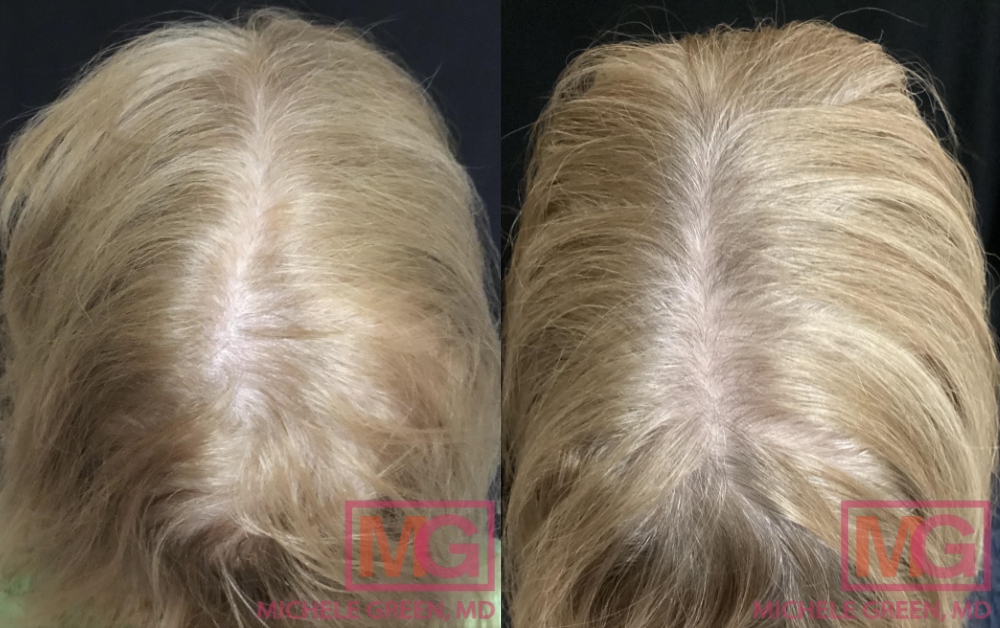
How do Platelet-rich plasma (PRP) injections for hair growth work?
The first step in using PRP for hair growth is consulting with board-certified dermatologist Dr. Michele Green in her upper East side private dermatology office. During your consultation, she will assess your medical history, physically assess your hair and scalp, and review any previous treatments you may have had. She will then create a unique PRP treatment plan suited to your concerns and goals. Often, PRP treatment can be performed on the same day as your consultation.
PRP treatment begins with drawing blood from the patient’s arm and spinning it in a centrifuge to remove the platelet-rich plasma from red blood cells, platelet-poor plasma, and other blood components. The PRP is then injected straight into the scalp. Injections are typically performed in areas where hair loss is the greatest, though the PRP will diffuse into the entire scalp during treatment. While there is some pain associated with the procedure, patients can either apply a topical numbing solution or an ice pack to the scalp to minimize discomfort. Treatment is quick and simple, and patients can resume a majority of their daily activities after the procedure. Dr. Green advises her patients not to wash their hair, use hair styling products, or engage in strenuous exercise for 24 hours. Alcohol and smoking should be avoided for three days following treatment. When you consult with Dr. Green in her private NYC dermatology office, she will provide you with all the necessary aftercare instructions for treatment and help you schedule your follow-up and maintenance treatments.
What are the side effects of PRP therapy for hair treatment?
The risk of experiencing side effects as a result of PRP therapy is very low, especially when you receive treatment from an expert dermatologist, such as Dr. Green. A common and mild side effect that patients may experience is slight soreness or redness at the injection site, which should resolve on its own after several days. When seeking treatment from a less experienced injector, the risk of developing more severe side effects increases. Patients of inexperienced practitioners may be at a higher risk of blood vessel or nerve damage on the scalp, scarring or calcification of tissue, and infection at the injection site. If you have a history of severe scarring, please be sure to let Dr. Green know before you get treatment.
Are PRP injections safe for hair restoration?
PRP treatment is a very safe and effective treatment for hair regrowth and hair loss prevention. Unlike other hair loss prevention treatments, PRP therapy is associated with very few side effects, especially when a board-certified dermatologist, such as Dr. Green, performs the procedure. Part of the reason for the lack of side effects is that PRP treatment uses plasma from the patient’s own blood, meaning that there is no risk for an allergic reaction. PRP treatment is quick and easy to perform and requires no downtime, meaning that patients can immediately resume their regularly scheduled activities after their appointment.
How much PRP is effective?
Typically, an initial series of four PRP treatment sessions, each spaced one month apart, is best to see the most effective results. Depending on your response to treatment, Dr. Green may have you come back one to three times a year to keep and maintain the effects of platelet-rich plasma treatment.
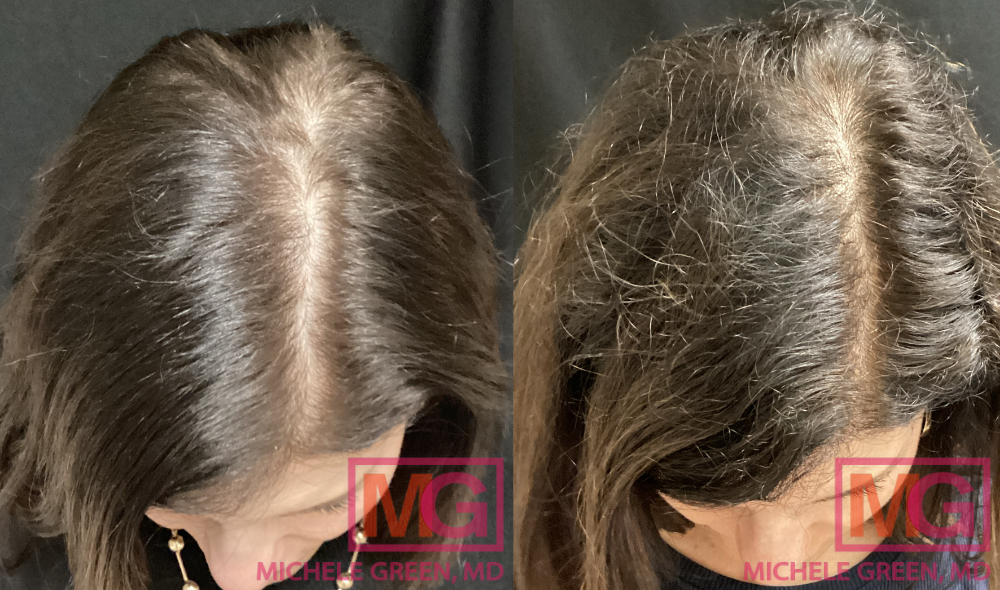
How long does PRP last for hair loss?
It can take several weeks for the full effects of the treatment to be apparent after each round of treatments. Most patients will experience a natural thickening and regrowth of hair in the weeks following the procedure. However, the peak of collagen production typically occurs approximately three months after the injections. PRP for hair loss has long-lasting results but typically requires maintenance treatments to maintain them.
Does PRP actually regrow hair?
Yes! Many patients in Dr. Green’s office often wonder, “Will hair grow after PRP?” PRP treatment is highly effective in preventing hair loss and hair thinning, and also works to regrow hair and promote thicker, healthier hair growth. Various types of hair loss conditions can occur, which can cause the hair follicles to become weak and inactive. With PRP treatment, the growth factors present in the injection help to reactivate hair follicles and promote hair regrowth at the injection site. For patients who are dealing with balding in varying forms, Dr. Green will often recommend PRP therapy to reverse signs of hair loss.
Is PRP proven to work?
Yes! PRP has been demonstrated in several key studies to stop hair loss from occurring and to promote new hair growth. A study published in the Journal of Cutaneous and Aesthetic Surgery in 2014 (doi: 10.4103/0974-2077.138352) demonstrated that when PRP was injected into the scalp every other week for three months, the number of hair follicles increased, promoting healthier hair growth. A study published in the International Journal of Trichology (doi: 10.4103/ijt.ijt_64_18) compared the effects of PRP treatment with the effects of topical minoxidil, also known as Rogaine. The study demonstrated that PRP was more effective at preventing hair loss than Rogaine was and had fewer side effects. When compared with other treatments, such as topical minoxidil and oral finasteride (Propecia), PRP frequently performs better and is not associated with the same frustrating side effects. For men, such medications can often lead to side effects, such as erectile dysfunction, and for women, side effects can include facial hair growth and low blood pressure. For that reason, PRP is quite often the best option for preventing hair loss.
What is the success rate for PRP for hair loss?
The success rate for PRP depends on various factors, including the type and severity of hair loss at the start of treatment. Each patient is unique, and no one person responds the same way to PRP treatment. However, PRP injections have proven to be an incredible treatment for hair restoration, working to reduce hair loss, increase hair density and thickness, and regrow hair. In some cases, Dr. Green may recommend combining PRP treatment with oral or topical medications to treat and prevent hair loss. When you consult with Dr. Green, she will assess your medical history, type of hair loss, and hair concerns to tailor a hair restoration treatment plan that will leave you with thicker, full hair that lasts.
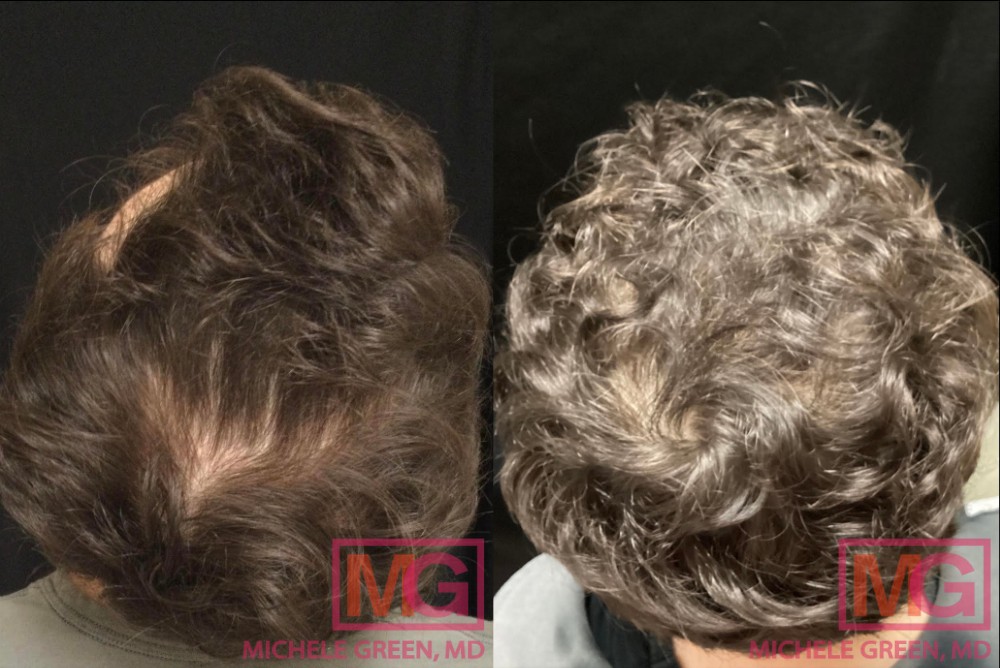
How much is PRP treatment for hair?
When patients ask, “How much is PRP for hair growth?”, the answer is that it depends. Treatment cost can vary based on your geographic location, the type of institution at which you receive treatment, the severity of hair loss, and the size of the treatment area. While seeking treatment from an expert, board-certified dermatologist, such as Dr. Green, may be more expensive than receiving treatment from a less experienced practitioner, the risk of developing serious side effects decreases when you receive treatment from an expert. The number of treatments can also affect the full price of each round of treatments, and the number of treatment sessions needed can depend on the size and scope of the treatment area as well as the condition being treated. After your initial consultation with Dr. Green, her office will be able to provide you with a clearer estimate of the cost of the treatment based on these factors.
Is PRP for hair worth the money?
Yes! PRP is an innovative and effective treatment that prevents further hair loss and stimulates new hair growth. While PRP may be pricier than topical or oral medications, treatment has shown to be even more effective than standard hair loss therapies. Additionally, PRP treatment is associated with far fewer side effects than medications such as finasteride, which can cause sexual dysfunction in men, and minoxidil, which can result in increased facial and bodily hair growth in women. PRP is 100% safe, as it is derived from a patient’s blood. After an initial series of treatments, patients typically only need to engage in one to three PRP injections a year, drastically reducing the cost associated with treatment. Patients undergoing PRP treatment for hair loss and restoration can look forward to reduced thinning and shedding and increased hair growth.
How to get started with PRP therapy for hair loss treatment today
If you are experiencing hair loss, you are not alone – millions of Americans battle with hair loss every year. Hair loss can feel very distressing, as many patients identify deeply with their hair, and balding can represent the worst part of the natural aging process. Luckily, Dr. Green can help prevent hair loss, hair thinning, and balding through the use of platelet-rich plasma therapy. PRP can help improve hair loss due to androgenic alopecia, alopecia areata, and telogen effluvium. PRP contains autologous growth factors that aid in tissue regeneration, healing, and growth. Thanks to PRP injections with Dr. Green, patients can look forward to thicker, fuller hair that lasts.
Dr. Michele Green is a board-certified dermatologist with over two and a half decades of experience treating the world’s most discerning men and women with non-invasive treatments, including PRP injections for hair restoration. She is consistently rated as one of New York City’s top dermatologists by Castle Connolly, Super Doctors, New York Magazine, and The New York Times due to her expertise and dedication to her patients. Dr. Green takes a holistic approach to dermatology, customizing each patient’s treatment plan to suit their specific concerns and needs. If you are struggling with hair loss and are interested in PRP injections, schedule a consultation with Dr. Green in NYC by calling 212-535-3088 or contacting us online today.
 212-535-3088
212-535-3088